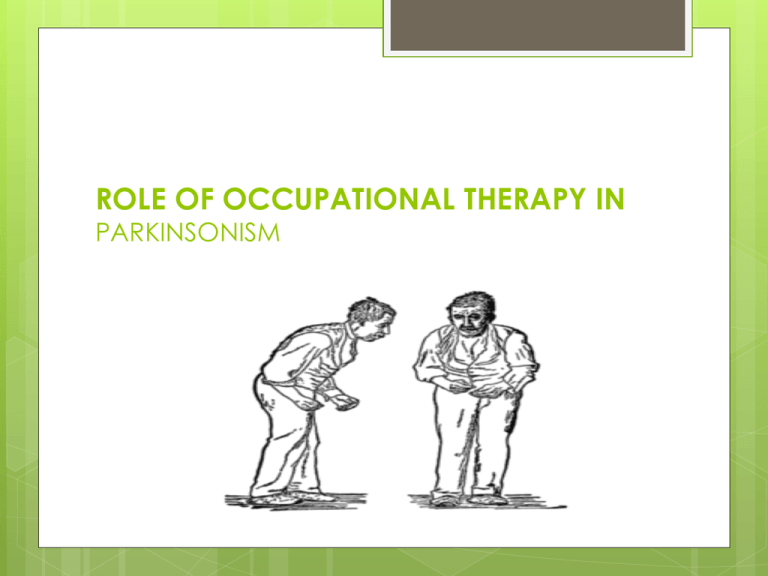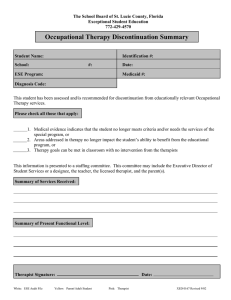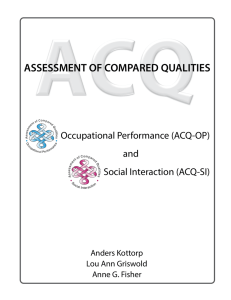ROLE OF OCCUPATIONAL THERAPY IN PARKINSONISM
advertisement

ROLE OF OCCUPATIONAL THERAPY IN PARKINSONISM HISTORY OF DISEASE First described in 1817 by an English physician, James Parkinson, in “An Essay on the Shaking Palsy.” The famous French neurologist, Charcot, further described the syndrome in the late 1800s. Three cardinal symptoms 1. Resting tremor: Most common first symptom, usually asymmetric and most evident in one hand with the arm at rest. 2. Brady kinesia Difficulty with daily activities such as writing, shaving, using a knife and fork, and opening buttons; decreased blinking, masked facies, slowed chewing and swallowing. 3. Rest tremor Muscle tone increased in both flexor and extensor muscles providing a constant resistance to passive movements of the joints; stooped posture, anteroflexed head, and flexed knees and elbows. Other Features: 1. Postural Instability: loss of postural reflexes. 2. Dysfunction of Autonomic Nervous system: Impaired gastrointestinal motility, bladder dysfunction, sialorrhea, excessive head and neck sweating, and orthostatic hypotension. 3. Depression:Mild to moderate depression in 50 % of patients. 4. Cognitive impairment: Mild cognitive decline including impaired visual-spatial perception and attention, slowness in execution of motor tasks, and impaired concentration in most patients; at least 1/3 become demented during the course of the disease. THE ROLE OF OCCUPATIONAL THERAPIST FOR PEOPLE WITH PARKINSON’S INCREASE AND MAINTAIN INDEPENDENCE IN ACTIVITIES OF DAILY LIVING (ADL’s) INCREASE MOBILITY & COORDINATION Activities of Daily Living(ADL’s) Basic ADL’s Self care Feeding Grooming Dressing Bathing Personal hygiene Toileting Instrumental ADL’s Interaction with physical environment Putting things away & getting things out of the closet Telephoning Written communication Using paper money, checks or coins Using books, newspapers & entertainment equipments Using public/private transportation Leisure activities Dressing: Warm & light room. • Firm seat with both feet on the floor with back supported. Clothing: •Easy to handle. •Light weight •warm /stretchy fabrics •Easily laundered •Cotton – or cotton – polyester •Wide openings Aids: •Elastic laces •Shoe horn •Slipper – socks • Eating: Begin meal slightly ahead of the rest of his family Eat little and often One course of main meal at midday 2nd course on the evening Half filled mug(tremor) Aids: Padded /light weight cutlery Plate guards Non slip mats Weighted bracelets (not too heavy) Mugs & cups with two enlarged handles Correct positioning. It may be useful to reduce the distance between the hands and mouth e.g. raising the table or plate, or by positioning the patient so that his elbows can be used as a pivot in order to assist hand movement Home Safety and Management •Even floor. •Non-slip polishes •Grab rails e.g. bath, toilet, steps. •Plan but flexible routine will help to conserve energy. •Non-iron and dip-dry fabrics. Carrying aids: •Net bag clipped to the walking frame. •Trolley or an apron with large pockets all reduce the danger of tripping •Alarm system •Telephone Bathing: •Shower chair •Non-slip bath mat Beds: •Firm mattress •Grab rail by the bed •Night light luminous •Alarm clock •Light left on in the hallway Mobility & Co-ordination Aim (1) (2) (3) Gait Balance Transfers 1. Gait: Rx Aim: • To improve size & rhythm of the walking pattern • Large; rhythmical bilateral non-resisted movements Walking • Practice using foot outlines lines marked on the floor at paced intervals are all suitable. • Activities which encourage walking should be under supervision. 2. Balance:Initially •Work at a balance table. •Mirror Later •Encourage side flexion and rotation. •Encouraged to bend and stoop, such as gardening and skittles. •Wedged shoes •Leather soled shoes •Weighted clothing. •Raised chairs /beds. •Inclined seats reduces the risk of over balancing when rising. Initiating Movement •Rocking motion with verbal stimulus •“one, two, three go!” •Counting, •Marching, •Music, or rhythmic encouragement •‘step and step and ….’ •One step backward before attempting to walk forward. Auditory & visual stimuli (received when climbing up stairs often makes this activity easier than walking on level ground). 3.Transfers: •Stable & firm surface. •A firm wedged cushion or rocking motion for rising from sitting. •Raise the back legs of a chair slightly. •Steady high chair with arm rest. Co-ordination: •large bilateral and rhythmic activities with little resistance. •As co-ordination improves the time spent on each activity can be increased and the size of movement decreased. •Regular practice of writing patterns. Writing: Initially: •Blackboard •large poster-sized sheets of paper Later : •Rhythmical writing patterns using widely spaced lines. •Progressions to writing letters and words. Writing aids: Padded pens Writing board Roller ball pen (easier than fountain or ball point pen). Support for the patient and his family •Reassure •Therapist should help the family to be realistic in their expectations. •The family should not expect the patient to perform activities beyond his capacity, but emphasize those he can do. Social Activities Work in small groups (to avoid isolation and to assist communication). •Positive and purposeful. •Familiar and interesting activities •A wide variety of stimuli in the form of colour, sound and touch. •The therapist should work within the concentration span of the patient. •Maintain social contact through •Hobbies •Pastimes. •Visits. •Outings. work •Part-time work. •less responsibility at work may be considered. •It is unwise for the patient to persist with work to the point where he becomes exhausted and possibly unsafe. REFERENCES THE PRACTICE OF OCCUPATIONAL THERAPY An introduction to the treatment of Physical Dysfunction (II EDITION-ANN TURNER) QUICK REFERENCE TO OCCUPATIONAL THERAPY ( KATHLYN L.REED) WILLARD AND SPACKMAN’S OCCUPATIONAL THERAPY (XI EDITION)


